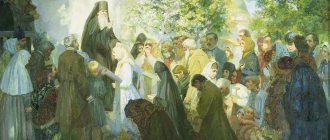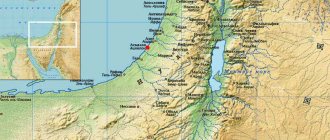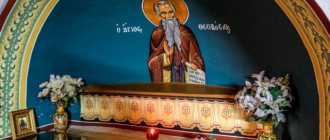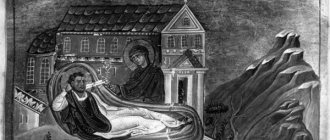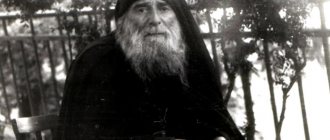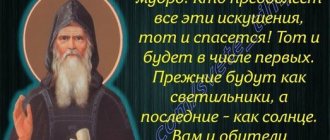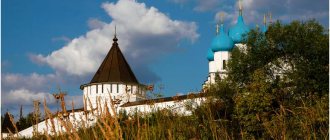| Rev. Sergiy Nuromsky. Tomb icon. Beginning of the 18th century (before 1715) Wood, gesso, tempera. 201 × 68.5 cm Vologda State. historical, architectural and art museum-reserve |
Sergius of Obnor, Nurom, Vologda
(+ 1412), venerable Memory of October 7, in the Cathedrals of the Athos venerables, venerable Russian Svyatogortsev, as well as Vologda and Radonezh saints
He was Greek by origin. He was tonsured and ordained as a hieromonk on Holy Mount Athos.
In the second half of the 14th century [1] he came to the Radonezh forests to his famous venerable namesake. According to Saint Demetrius of Rostov, he remained “under the flock of the great Russian luminary Sergius for a long time” [2]. By practicing ascetic deeds, prayers, and doing good deeds, he became spiritually stronger and became internally ready for the feat of living in the desert.
Having asked for the blessing of the great Sergius, approximately in 1386-1389 [3] he came to the Vologda forests, to the Nurma River, where he chose as the site of his feat “an area covered with wilds, forests, mosses and swamps” [4]. In the same place, four miles from him, another disciple of the Radonezh Abba, the Monk Pavel Obnorsky, asceticised.
At the chosen place, Sergius erected a cross, built a chapel and a small cell, and over time dug a well nearby.
With great patience he labored for many years, enduring attacks from demons and evil people. The life preserved two cases of attacks on Sergius by robbers. The first time they brutally beat him and, leaving him half-dead, they left without finding any treasures, tearing apart his cell, the chapel, and turning out the cross. The second time, the Lord miraculously delivered his saint: fear and horror seized the robbers, and they ran out of the cell screaming and never again annoyed the saint. The life also preserved the words of the saint: “I will not leave this place, even if the enemy conjures up a thousand intrigues against me.
I wish to die in this place, for I came here seeking Christ” [2].
Gradually, the news about Sergius spread throughout the area, and people began to come to him. When about forty people [1] gathered who wanted to stay and live with the saint, he began to build a church in the name of the All-Merciful Savior, in memory of the origin of His Honorable and Life-Giving Cross, as well as cells for the brethren. This is how the Nurom Monastery was formed.
Around this time, a meeting between St. Sergius and St. Paul took place. The saints became friends and spiritual mentors to each other. Sergius became Paul's confessor, who gained the opportunity to partake of the Holy Mysteries of Christ. Shortly before his death, at the last meeting of the holy saints, Sergius blessed Paul to build a monastery in the name of the Holy Trinity in the place where Paul saw an extraordinary light and heard the ringing of bells on Easter night. Sergius blessed his disciple Alexy to help Pavel, who became the first abbot of the monastery being established.
Having reached a very old age, having suffered a serious illness, and having received the Holy Mysteries, Saint Sergius reposed on October 7, 1412. Before his death, he gave his last teaching to the brethren:
But you, children, do not grieve over my departure, but remain in the love of God and keep His commandments, remembering with fear and trembling the word of the Lord Christ: If you have My commandments and keep them, that is to love Me (John 14:21). Guard your hearts with the fear of God, so that He may guide you in every good deed, for the fear of the Lord is the beginning of wisdom (Wis 1:7); decorate each other with humility, turn away from false speech, tell each other the truth, hate slander, avoid enmity. But if any of you allows anger into his heart, you will persuade him with love, for it is written: Let not the sun go down on your anger (Eph 4:26). Submit to your guides, for they watch over your souls, since they must give an answer to God for you. Perform church services without laziness. If you live like this, you will be blessed
[5].
| Cancer over the burial place of St. Sergius Nuromsky. Temple of the All-Merciful Savior, Origin of the Honest Trees of the Life-Giving Cross of the Lord. Village of Spas-Nurma. (the relics of the saint are kept under wraps) |
Life of St. Sergius of Nurom
Monk Sergius in the second half of the 14th century moved to Rus', to the monastery of St. Sergius of Radonezh, in order to continue his monastic life under his leadership. Here he remained for several years, being in obedience to the abbot of the Trinity Monastery. Then Sergius wished to retire to a deserted place to spend more time in prayer and spiritual self-improvement. Having asked for the blessing of Sergius of Radonezh, approximately in 1386-1389 he came to the Vologda forests, to the Nurma River, where he chose as the site of his feat “an area covered with wilds, forests, mosses and swamps.” In the same place, four miles from him, another disciple of Sergius of Radonezh, Pavel Obnorsky, labored.
At the chosen place, Sergius erected a cross, built a chapel and a small cell, and over time dug a well nearby. With great patience he labored for many years, enduring attacks from demons and evil people. The life preserved two cases of attacks on Sergius by robbers. The first time they brutally beat him and, leaving him half-dead, they left without finding any treasures, tearing apart his cell, the chapel, and turning out the cross. The second time, the Lord miraculously delivered his saint: fear and horror seized the robbers, and they ran out of the cell screaming and never again annoyed the monk.
Gradually, the news about the monk Sergius spread throughout the area, and people began to come to him. When about forty people gathered who wanted to stay and live with him, he began to build a church in the name of the All-Merciful Savior, in memory of the origin of His Honorable and Life-Giving Cross, as well as cells for the brethren. This is how the Nurom Monastery was formed. Around the same time, Sergius met with Pavel Obnorsky. Sergius became Paul's confessor, who gained the opportunity to partake of the Holy Mysteries of Christ. Shortly before his death, at his last meeting, Sergius blessed Paul to build a monastery in the name of the Holy Trinity on the spot where Paul saw an extraordinary light and heard the ringing of bells on Easter night. Sergius blessed his disciple Alexy to help Pavel, who became the first abbot of the monastery being established.
Having reached a very old age, having suffered a serious illness, having received the Holy Mysteries, the Monk Sergius reposed on October 20 (October 7, Old Style), 1412.
On October 7/20, the Church commemorates St. Sergius of Nurom, who came to the monastery of St. Sergius of Radonezh from Holy Mount Athos.
Holy Hierarch Ecumenical Patriarch Philotheus Kokkin in the mid-1360s sends an extremely important message to St. Sergius of Radonezh, in which he calls on him to introduce a cenobitic rule in his monastery: “Therefore, I also give you the blessing and permission to create a holy monastery, and the mercy and grace of the Divine May the Trinity be with you forever...”
From this cenobitic monastery other forty monasteries originate. In total, fifty monasteries were founded by the disciples of St. Sergius.
The Life of St. Sergius of Obnor, Nurom was written in 1584 under Tsar Ivan IV Vasilyevich, Metropolitan Daniel and Bishop of Vologda and Velikoperm Varlaam. Its compiler was Jonah, abbot of the Glushitsky monastery, who wrote his life according to the notes of Protasius, abbot of the Pavlo-Obnorsky monastery.
From this life, however, it is not clear where the Monk Sergius was from. Some sources say that he was originally Greek. What is certain is that this lover of silence began his monastic life on Mount Athos, where he labored for quite some time and was invested with the priesthood.
Then, having come from the East to the borders of Moscow, Sergius of Vologda Nuromsky also sought spiritual enlightenment from the Radonezh luminary of the same name and spent a lot of time under his leadership. But the Athonite silent man thought, according to the word of the psalm, to flee and settle in the deepest desert and, with the blessing of the great Sergius of Radonezh, after some time he actually retired to the Vologda forests.
Here, on the rocky bank of the Nurma River, he settled, while the Monk Paul of Obnorsky asceticised not far from there, in the inner desert, in the hollow of a linden tree. Having erected a cross and built a chapel with a cell, the Monk Sergius began to asceticize in deep silence until his disciples began to gather to him.
The monk suffered many attacks from spirits of evil and unkind people, robbers.
The life preserved two cases of attacks on Sergius by robbers. The first time they brutally beat him and, leaving him half-dead, they left without finding any treasures, tearing apart his cell, the chapel, and turning out the cross. The second time, the Lord miraculously delivered his saint: fear and horror seized the robbers, and they ran out of the cell screaming and never again annoyed the saint. Life has preserved the words of the monk: “I will not leave this place, even if the enemy conjures up a thousand intrigues against me. I wish to die in this place, for I came here seeking Christ.”
Word spread about the strict ascetic, and those thirsting for spiritual salvation began to come to him from everywhere, and settled near him in the booths. Little by little, the brethren gathered up to forty people. Then the saint built a small wooden temple of the Origin of the Honest Trees of the Life-Giving Cross of the Lord and founded a hostel.
Around this time, the meeting of St. Sergius with St. Paul takes place. Saints become friends and spiritual mentors to each other. Sergius becomes Paul's confessor. The Monk Paul gains the opportunity to partake of the Holy Mysteries of Christ.
The Monk Sergius and the Monk Pavel Obnorsky, who chose Sergius as their spiritual father, had great spiritual love between themselves. Shortly before his death, at the last meeting of the holy saints, Sergius blesses Paul to build a monastery in honor of the Holy Trinity on the spot where Paul saw an extraordinary light and heard the bells ringing on Easter night.
Sergius sent his disciple Alexei to assist Pavel, who became the first abbot of the monastery being established.
Having reached a very old age, having suffered a serious illness, on October 7/20, 1412, on the day of remembrance of the honorable martyrs Sergius and Bacchus, having partaken of the Holy Mysteries, the Monk Sergius betrayed his pure soul to God, teaching the last teaching to the brethren before his death.
“But you, children, do not grieve over my departure, but remain in the love of God and keep His commandments, remembering with fear and trembling the word of the Lord Christ: If you have My commandments and keep them, that is you who love Me (John 14:21).
Guard your hearts with the fear of God, so that He may guide you in every good deed, for the fear of the Lord is the beginning of wisdom (Wisdom 1:7); decorate each other with humility, turn away from false speech, tell each other the truth, hate slander, avoid enmity. But if any of you allows anger into his heart, you will persuade him with love, for it is said: Let not the sun go down on your anger (Eph. 4:26). Submit to your guides, for they watch over your souls, since they must give an answer to God for you. Perform church services without laziness. If you live like this, you will be blessed.”
The brothers buried the body of their shepherd near the Church of the Origin of the Trees of the Precious and Life-Giving Cross of the Lord, which he himself had created.
Many years after the saint’s repose, he appeared three times in a dream vision to one of the monks of his monastery, Nikifor, showed the place of his burial and ordered him to tell the abbot and the brethren to cleanse this place, “for the Lord does not want it to be unknown and neglected.”
After the discovery of the holy relics, veneration of the saint began, and miracles began to take place at his tomb. A life dating back to 1584 lists 104 miracles. Those possessed by demons and those who were insane received especially many healings at the tomb of the saint.
When exactly St. Sergius was canonized is not known for certain. But, since in 1583 prayers were already sung over his coffin, and in 1584 his life was recorded, and in the charter of Tsar Fyodor Ivanovich in 1585 he was called a “newly-minted miracle worker,” then, probably, his canonization followed one of the cathedrals that existed shortly before that time, in the second half of the 16th century.
The monastery of St. Sergius, closed in 1764, was located four miles from the monastery of Pavel Obnorsky, downstream of the Nurma River, in the Gryazovets district of the Vologda province. After its closure, the monastery was turned into a parish church.
Currently, the relics of St. Sergius of Nurom are hidden in the Church of the Origin of the Trees of the Precious and Life-Giving Cross of the Lord.
Reverend Father Sergius, pray to God for us!
pavelobnorskiy.cerkov.ru, afonit.info
Veneration of St. Sergius of Nurom
The monks buried the body of their shepherd near the temple he built in the name of the Origin of the Trees of the Precious and Life-Giving Cross of the Lord. Many years after the saint’s repose, he appeared three times in a dream vision to one of the monks of his monastery, Nikifor, showed the place of his burial and ordered the abbot and brethren to be told that the place should be cleansed, “for the Lord does not want it to be unknown and neglected.” After the discovery of the holy relics, veneration of the saint began, and miracles began to take place at his tomb. The Life, dating back to 1584, lists 104 miracles. Initially, the life of St. Sergius of Nurom was told by his disciple and first abbot of the Pavlova monastery, Alexy, to monk Anthony. He retold it to the monk Gennady, and from his words, Abbot Protasius of the Obnorsky Monastery put the life on paper for the first time. The scroll containing the story of the Nurom abbot was delivered to the Glushitsky abbot Jonah, who in 1584 compiled the Life of St. Sergius that has come down to us. In all likelihood, glorification as a saint took place in the same year, or in 1585.
The Spaso-Nuromsky Monastery conducted active economic activities in the 15th–17th centuries. The monastery was considered second in the diocese after the cathedral monasteries. In 1714, there were 14 villages associated with the monastery. By the time of closure, in 1764, there were 380 peasants. After closing it was converted into a parish church. In 1933 the church was closed. Restoration work is currently underway.
Currently, the relics of St. Sergius of Nurom are hidden in the Church of the Origin of the Trees of the Precious and Life-Giving Cross of the Lord, which he founded.
Abolition of the monastery
During Catherine's secularization reform of 1764, the monastery was abolished and turned into a parish. The brethren were transferred to the Pavlo-Obnorsky Monastery. The dilapidated wooden churches were then dismantled, and in 1795 the construction of a stone two-story parish church began, which was consecrated in 1816. It retained the names of the chapels of the monastery churches: the main upper church was consecrated in honor of the All-Merciful Savior and had a chapel in the name of St. Nicholas the Wonderworker; Below there was a throne in the name of Sergius of Nurom, in which the relics of the saint were hidden, with a side chapel of the Nativity of Christ.
Since 1768, the church has had two priests, a deacon and two sets of clergy. Subsequently, in 1831, the church became single-clergy, and since 1846 there were no deacons in it. By the middle of the 19th century, the parish church existed as the Spaso-Nuromsky churchyard. Behind the former monastery fence there was a cemetery.
Closing and revival of the temple
After the October Revolution, the temple was not closed, since a community of believers was formed under it, which took responsibility for it, but in 1922, valuables were removed from it. On February 25, 1930, the rector of the parish, priest Konstantin Tsipilev, was arrested and exiled to the north, followed by the deacon and psalm-reader. After this, parish life in the church ceased.
Since 1993, the Temple of the Origin of the Honest Trees of the Holy Cross has been restored. It belongs to the Holy Trinity Pavlo-Obnorsky Monastery.
Troparion and Kontakion to St. Sergius of Nurom
Troparion, tone 8.
ABOUT! you, Father Sergius, know the speed of salvation. Let us accept the cross, for you followed Christ. But whoever does and learns to despise the flesh passes away, but to practice things more immortal for the soul. In the same way the angels rejoice, O venerable spirit.
Kontakion, tone 2.
Divinely armed with purity of soul, and unceasing prayer, as if firmly handed over a copy, you prosecuted the demonic host, Sergius, Our Father, pray unceasingly for all of us.
Prayers
Troparion, tone 8
:
Inflamed with spiritual desire, you are rich, / you have filled your soul with the flow of your tears, / and even from the depths of sighs you have wounded your heart, / and with vigorous prayers, and with the all-night presence of Vlada To Christ / bear much virtuous fruit for yourself. / And for this reason, as a saint of God, he appeared brightly to the world, / shining miracles, Our Father Sergius, / a warm prayer book to God, always pray for us, // may He save our souls
.
Kontakion, tone 8
:
Like a bright star, having risen from the Holy Mountain, / the goodness of your miracles has enlightened the whole world, / for the cross of Christ is everywhere, following Him, / in desert embitterment, in prayers and forgiveness, / in vigils and suffering having exhausted their flesh, / thus Christ granted you the gift of miracles, / Praying to Him for us, visit your children, and let us call to you: // Rejoice, Our Father Sergius, desert dweller
.
Reverend Sergius of Nuromsky. Icons
The Venerable Sergius of Nurom is traditionally depicted on icons in full monastic vestments, with a blessing right hand and a scroll in his left hand.
Reverend Sergius of Nuromsky. Tomb icon, early 18th century. Vologda State historical, architectural and art museum-reserve
Venerable Sergius of Nuromsky with the monastery. 1691 Vologda State Historical, Architectural and Art Museum-Reserve St. Sergius of Nuromsky. Sergiev Posad, early 1950s
